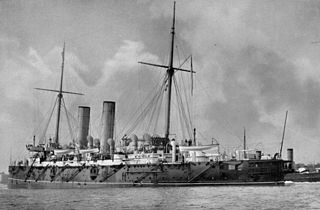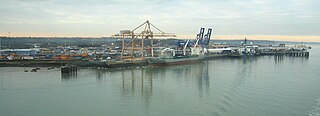 W
WThe Aberdeen Station was a naval station of the British Royal Navy its headquarters were at Aberdeen, Scotland Great Britain.
 W
WThe Naval Officer-in-Charge, Aden was an administrative appointment of British Royal Navy originally established in 1839 as the Senior Naval Officer, Aden. He was responsible for HMS Sheba. It was a sub-command of the Flag Officer, Middle East.
 W
WThe Commander-in-Chief, Africa was the last title of a Royal Navy's formation commander located in South Africa from 1795 to 1939. Under varying titles, it was one of the longest-lived formations of the Royal Navy. It was also often known as the Cape of Good Hope Station.
 W
WThe White Sea Station was a naval station of the British Royal Navy headquartered at Archangel, Russian Empire from 1917 to 1919. The station was commanded by the Rear-Admiral Commanding in the White Sea later the Senior Naval Officer, White Sea.
 W
WThe Aultbea Station, also known as the Loch Ewe and Aultbea Station, was a naval station of the British Royal Navy. Its headquarters were in Aultbea, Scotland. The station was commanded by the Senior Naval Officer, Aultbea and was in operation from 1915 to 1919 and again from 1940 to 1967.
 W
WThe Australia Station was the British, and later Australian, naval command responsible for the waters around the Australian continent. Australia Station was under the command of the Commander-in-Chief, Australia Station, whose rank varied over time.
 W
WThe Leeward Islands Station and originally known as the Barbadoes and Leeward Islands Station was a formation or command of the Kingdom of Great Britain and then the United Kingdom's Royal Navy stationed at English Harbour, Antigua, Leeward Islands from 1743 to 1821.
 W
WThe Basra station was a naval station of the British Royal Navy during World War One and World War Two. It was administered by the Naval Officer in Charge, Basra
 W
WThe Commander-in-Chief, Africa was the last title of a Royal Navy's formation commander located in South Africa from 1795 to 1939. Under varying titles, it was one of the longest-lived formations of the Royal Navy. It was also often known as the Cape of Good Hope Station.
 W
WThe Commander-in-Chief, China Station was the admiral in command of what was usually known as the China Station, at once both a British Royal Navy naval formation and its admiral in command. It was created in 1865 and deactivated in 1941.
 W
WThe Commander-in-Chief, China Station was the admiral in command of what was usually known as the China Station, at once both a British Royal Navy naval formation and its admiral in command. It was created in 1865 and deactivated in 1941.
 W
WThe Flag Officer Scotland and Northern Ireland (FOSNI) was a senior post in the Royal Navy of the United Kingdom. It was based at HM Naval Base Clyde and the holder of the post was the Royal Navy’s senior officer in Scotland. The post of FOSNI is the successor to the now defunct Flag Officer Scotland, Northern England & Northern Ireland.
 W
WThe Royal Navy was active in East African waters from the 1850s to the 1960s.
 W
WThe Commander-in-Chief, Africa was the last title of a Royal Navy's formation commander located in South Africa from 1795 to 1939. Under varying titles, it was one of the longest-lived formations of the Royal Navy. It was also often known as the Cape of Good Hope Station.
 W
WThe East Indies and China Station was a formation of the Royal Navy from 1831 to 1865.
 W
WThe East Indies Station was a formation and command of the British Royal Navy. Created in 1744 by the Admiralty, it was under the command of the Commander-in-Chief, East Indies.
 W
WHMS Badger was a shore establishment of the Royal Navy. She was commissioned on 13 September 1939 was the flag ship of the headquarters of the Flag Officer in Charge (FOIC), Harwich who was responsible to Commander-in-Chief, The Nore, and was decommissioned on 21 October 1946, although the Operations Room remained as the Emergency Port Control for the Harwich area. The site was Parkeston Quay, now Harwich International Port, and the bunker lies under Hamilton House, currently an occupational health centre, close to the entrance to Harwich International Port, a few miles west of Harwich.
 W
WThe Iceland (C) station was naval station of British Royal Navy established in 1941 and deactivated in 1945. It was initially commanded by the Admiral Commanding, Iceland (C), who was later renamed the Flag Officer Commanding, Iceland (C).
 W
WThe Jamaica Station was a formation or command of the United Kingdom's Royal Navy stationed at Port Royal in Jamaica from 1655 to 1830.
 W
WThe Leeward Islands Station and originally known as the Barbadoes and Leeward Islands Station was a formation or command of the Kingdom of Great Britain and then the United Kingdom's Royal Navy stationed at English Harbour, Antigua, Leeward Islands from 1743 to 1821.
 W
WThe Commander-in-Chief, The Nore, was an operational commander of the Royal Navy. His subordinate units, establishments, and staff were sometimes informally known as the Nore Station or Nore Command. The Nore is a sandbank at the mouth of the Thames Estuary and River Medway.
 W
WThe North America and West Indies Station was a formation or command of the United Kingdom's Royal Navy stationed in North American waters from 1745 to 1956. The North American Station was separate from the Jamaica Station until 1830 when the two combined to form the North America and West Indies Station. It was briefly abolished in 1907 before being restored in 1915. It was renamed the America and West Indies Station in 1926. It was commanded by the Commander-in-Chief, North America and West Indies Station and subsequently by the Commander-in-Chief, America and West Indies Station.
 W
WThe North America and West Indies Station was a formation or command of the United Kingdom's Royal Navy stationed in North American waters from 1745 to 1956. The North American Station was separate from the Jamaica Station until 1830 when the two combined to form the North America and West Indies Station. It was briefly abolished in 1907 before being restored in 1915. It was renamed the America and West Indies Station in 1926. It was commanded by the Commander-in-Chief, North America and West Indies Station and subsequently by the Commander-in-Chief, America and West Indies Station.
 W
WThe Commander-in-Chief, North Sea was senior appointment and an operational command of the British Royal Navy originally based at Great Yarmouth from 1745 to 1802 then at Ramsgate from 1803 until 1815.
 W
WThe Pacific Station was created in 1837 as one of the geographical military formations into which the Royal Navy divided its worldwide responsibilities. The South America Station was split into the Pacific Station and the South East Coast of America Station.
 W
WThe Red Sea Station was one of the geographical divisions into which the Royal Navy divided its worldwide responsibilities. At various times it has also been referred to as Red Sea Division, Egypt Division and Red Sea and later the Red Sea and Canal Area it operated from 1846 until 1959 when it was unified with the Senior Naval Officer, Persian Gulf under the new appointment of Commodore, Arabian Seas and Persian Gulf.
 W
WSheerness Dockyard also known as the Sheerness Station was a Royal Navy Dockyard located on the Sheerness peninsula, at the mouth of the River Medway in Kent. It was opened in the 1660s and closed in 1960.
 W
WThe South America Station was a formation of the Royal Navy which existed from 1808 to 1838 when it was split into the Pacific Station and the South East Coast of America Station.
 W
WThe Commander-in-Chief South Atlantic was an operational commander of the Royal Navy from 1939. The South American area was added to his responsibilities in 1960, and the post disestablished in 1967.
 W
WThe Commander-in-Chief South Atlantic was an operational commander of the Royal Navy from 1939. The South American area was added to his responsibilities in 1960, and the post disestablished in 1967.
 W
WThe Commander-in-Chief, The Nore, was an operational commander of the Royal Navy. His subordinate units, establishments, and staff were sometimes informally known as the Nore Station or Nore Command. The Nore is a sandbank at the mouth of the Thames Estuary and River Medway.
 W
WThe Royal Navy established the West Africa Squadron at substantial expense in 1808 after Parliament passed the Slave Trade Act of 1807, an Act for the Abolition of the Slave Trade. The squadron's task was to suppress the Atlantic slave trade by patrolling the coast of West Africa. With a home base at Portsmouth, it began with two small ships, the 32-gun fifth-rate frigate HMS Solebay and the Cruizer-class brig-sloop HMS Derwent. At the height of its operations, the squadron employed a sixth of the Royal Navy fleet and marines. In 1819 the Royal Navy established a West Coast of Africa Station and the West Africa Squadron became known as the Preventative Squadron. It remained an independent command until 1856 and then again 1866 to 1867.
 W
WThe North America and West Indies Station was a formation or command of the United Kingdom's Royal Navy stationed in North American waters from 1745 to 1956. The North American Station was separate from the Jamaica Station until 1830 when the two combined to form the North America and West Indies Station. It was briefly abolished in 1907 before being restored in 1915. It was renamed the America and West Indies Station in 1926. It was commanded by the Commander-in-Chief, North America and West Indies Station and subsequently by the Commander-in-Chief, America and West Indies Station.
 W
WThe White Sea Station was a naval station of the British Royal Navy headquartered at Archangel, Russian Empire from 1917 to 1919. The station was commanded by the Rear-Admiral Commanding in the White Sea later the Senior Naval Officer, White Sea.